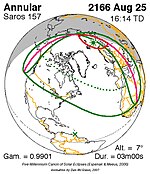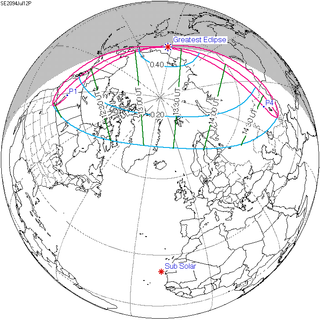Solar eclipse of July 12, 2094
| Solar eclipse of July 12, 2094 | |
|---|---|
| Type of eclipse | |
| Nature | Partial |
| Gamma | 1.3150 |
| Magnitude | 0.4224 |
| Maximum eclipse | |
| Coordinates | 68°00′N 52°48′E / 68°N 52.8°E |
| Times (UTC) | |
| Greatest eclipse | 13:24:35 |
| References | |
| Saros | 157 (3 of 70) |
| Catalog # (SE5000) | 9720 |
A partial solar eclipse will occur at the Moon's ascending node of orbit on Monday, July 12, 2094, with a magnitude of 0.4224. A solar eclipse occurs when the Moon passes between Earth and the Sun, thereby totally or partly obscuring the image of the Sun for a viewer on Earth. A partial solar eclipse occurs in the polar regions of the Earth when the center of the Moon's shadow misses the Earth.
Related eclipses[edit]
Eclipses in 2094[edit]
- A partial lunar eclipse on January 1, 2094.
- A total solar eclipse on January 16, 2094.
- A partial solar eclipse on June 13, 2094.
- A total lunar eclipse on June 28, 2094.
- A partial solar eclipse on July 12, 2094.
- A partial solar eclipse on December 7, 2094.
- A total lunar eclipse on December 21, 2094.
Metonic[edit]
- Preceded by: Solar eclipse of September 23, 2090
Tzolkinex[edit]
- Preceded by: Solar eclipse of June 1, 2087
- Followed by: Solar eclipse of August 24, 2101
Half-Saros[edit]
- Preceded by: Lunar eclipse of July 7, 2085
- Followed by: Lunar eclipse of July 19, 2103
Tritos[edit]
- Preceded by: Solar eclipse of August 13, 2083
- Followed by: Solar eclipse of June 12, 2105
Solar Saros 157[edit]
- Preceded by: Solar eclipse of July 1, 2076
- Followed by: Solar eclipse of July 23, 2112
Inex[edit]
- Preceded by: Solar eclipse of August 2, 2065
- Followed by: Solar eclipse of June 23, 2123
Triad[edit]
- Preceded by: Solar eclipse of September 11, 2007
- Followed by: Solar eclipse of May 13, 2181
Solar eclipses of 2091–2094[edit]
This eclipse is a member of a semester series. An eclipse in a semester series of solar eclipses repeats approximately every 177 days and 4 hours (a semester) at alternating nodes of the Moon's orbit.[1]
| Solar eclipses 2091 to 2094 | |||||
|---|---|---|---|---|---|
| 122 | February 18, 2091 Partial |
127 | August 15, 2091 Total | ||
| 132 | February 7, 2092 Annular |
137 | August 3, 2092 Annular | ||
| 142 | January 27, 2093 Total |
147 | July 23, 2093 Annular | ||
| 152 | January 16, 2094 Total |
157 | July 12, 2094 Partial | ||
Saros 157[edit]
It is a part of Saros cycle 157, repeating every 18 years, 11 days, containing 70 events. The series will start with a partial solar eclipse on June 21, 2058. It contains annular eclipses from August 25, 2166 through March 10, 2491, hybrid eclipses from March 22, 2509 through April 12, 2545, and total eclipses from April 24, 2563 through April 21, 3158. The series ends at member 70 as a partial eclipse on July 17, 3302. The longest duration of totality will be 5 minutes, 57 seconds on July 31, 2725.
| Series members 1–8 occur between 2058 and 2200: | ||
|---|---|---|
| 1 | 2 | 3 |
 June 21, 2058 |
 July 1, 2076 |
 July 12, 2094 |
| 4 | 5 | 6 |
 July 23, 2112 |
 August 4, 2130 |
 August 14, 2148 |
| 7 | 8 | |
 August 25, 2166 |
 September 4, 2184 | |
Metonic series[edit]
The metonic series repeats eclipses every 19 years (6939.69 days), lasting about 5 cycles. Eclipses occur in nearly the same calendar date. In addition, the octon subseries repeats 1/5 of that or every 3.8 years (1387.94 days). All eclipses in this table occur at the Moon's ascending node.
| 21 eclipse events, progressing from south to north between July 13, 2018 and July 12, 2094 | ||||
|---|---|---|---|---|
| July 12–13 | April 30-May 1 | February 16–17 | December 5–6 | September 22–23 |
| 117 | 119 | 121 | 123 | 125 |
 July 13, 2018 |
 April 30, 2022 |
 February 17, 2026 |
 December 5, 2029 |
 September 23, 2033 |
| 127 | 129 | 131 | 133 | 135 |
 July 13, 2037 |
 April 30, 2041 |
 February 16, 2045 |
 December 5, 2048 |
 September 22, 2052 |
| 137 | 139 | 141 | 143 | 145 |
 July 12, 2056 |
 April 30, 2060 |
 February 17, 2064 |
 December 6, 2067 |
 September 23, 2071 |
| 147 | 149 | 151 | 153 | 155 |
 July 13, 2075 |
 May 1, 2079 |
 February 16, 2083 |
 December 6, 2086 |
 September 23, 2090 |
| 157 | ||||
 July 12, 2094 | ||||
References[edit]
- ^ van Gent, R.H. "Solar- and Lunar-Eclipse Predictions from Antiquity to the Present". A Catalogue of Eclipse Cycles. Utrecht University. Retrieved 6 October 2018.




